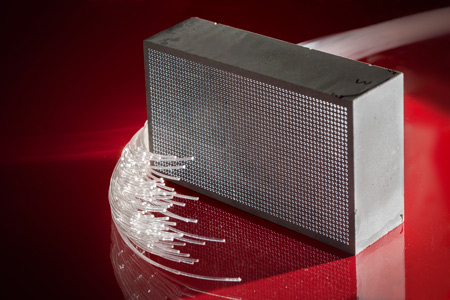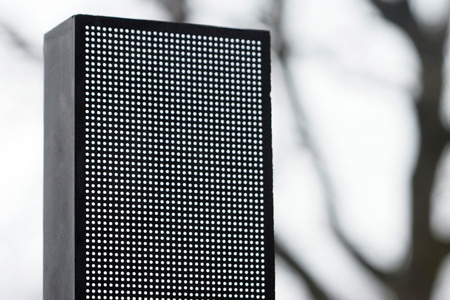Imagine Times Square in New York: illuminated day and night by every colour under the sun, façades covered by huge billboards and spots, and flashing advertisements trying to get their message across. The advertisements are mounted at the top of the façades where the fragile screens are protected from the vibrating everyday city life and vandalism. However, a new way of combining optical fibres, LED, and concrete introduces the possibility of mounting screens on building façades at eye level, thereby changing the street scene. What might look like a rough concrete surface at first sight has the ability to create an atmosphere, display a film, and shape the diversity of the urban landscape.
Together with a number of international partners, and in collaboration with the Danish Technological Institute and the Danish company Dupont Lightstone, DTU has received EU funding for developing and maturing the new screen technology. The target market has been part of the project from the very outset in the form of a manufacturer of advertising signs, who is buying the product when it is ready for launch.

|
|
Optical fibres cast directly into concrete offer unprecedented opportunities for displaying films, advertisements, or football matches directly on the wall. In high quality and without mounting any screens.
|
Simple and complex screen
Although the idea behind the new product sounds fairly simple, it presents a number of technological challenges. The principle is an LED screen hidden behind several centimetres of concrete. Optical fibres are embedded into the concrete and transmit the light from the LEDs to the concrete surface, making it possible to display moving images directly on the surface. Karsten Rottwitt, Professor at DTU Fotonik, explains:
"Light normally travels in straight lines. If you, for instance, point a laser towards the wall, it won't bend but rather turn into a dot. However, it is actually possible to force light to bend around corners and to twist and turn it. Nevertheless, this requires a type of material capable of transmitting light. The trick is basically to catch the light by means of two types of material with different refractive indexes: a core with one refractive index surrounded by a 'shell' of material with a different refractive index. In that way, the light can be transmitted through an optical fibre, where it is caught and not released until reaching the other end," he says.
One of the first decisions DTU had to make was whether it was necessary to use optical fibres instead of just filling up the holes in the concrete with a plastic material or even leaving them filled with air. However, they soon established that it would result in massive light loss to use methods other than optical fibres.
"Then we examined the proper size for the optical fibres. The area for the optical fibre is taken from the concrete, and although a sharp image is of major importance, it is just as important to make sure the concrete retains its strength," says Karsten Rottwitt, adding that the optical cable size is vital to colour reproduction: "If you display a film on the screen, you don't want people's faces to be completely yellow."

A million LEDs
What has proven more complicated is for the DTU researchers to advise the partners on how to connect the millions of light-emitting diodes constituting an LED screen with the individual optical fibres. The optical fibres must be placed with extreme precision opposite the diode—otherwise there will be a major light loss. And this is not an easy task, considering there are one million diodes.
"An optimal laser is capable of transmitting 80-85 per cent of the light if the diodes are placed exactly opposite the optical fibre, and if a lens is also used. If this isn't done right, the light loss will be far greater. We have recommended placing a sheet or mesh between the diodes and the optical fibres to create a so-called coupling which catches and concentrates the amount of light transmitted. The mesh typically consists of several layers— one layer with holes and one layer with lenses, like spectacle lenses, which are pressed into the holes. The lens collects the light, thereby facilitating the coupling as the precision of the position is less critical," says Professor Rottwitt.
Nevertheless, knowledge about the right optical fibres, about which refractive index is best suited for the purpose, and about advanced couplings and meshes is not enough to succeed in realizing the new screen technology. Therefore, one of the partners in the project has been the Concrete Centre at the Danish Technological Institute, which is heading the project, because the concrete screens must be cast, the optical fibres must be integrated into the screen, and the right production process must be established.
Concrete is not just concrete
The type of digital advertising signs already forming part of the urban landscape renders it possible to use a computer to control screens all over the world—to change advertising banners, videos, and information. The technology already exists, but many people with an aesthetic sense are probably not very fond of the ungraceful screens which, without mercy, are placed on building façades.
"But what if we embedded the screens into the façade already during the construction of the building? When the screen is switched off, the façade will look no different than the rest of the buildings, which will create a much more aesthetic urban landscape," says Bo Jacobsen, Managing Director at Dupont Lightstone.
This is where the experts at the Concrete Centre come in. Lars Nyholm Thrane, Senior Consultant at the Danish Technological Institute, has been involved in the development from the outset with a particular focus on the production processes:
"When you look at the prototype of the screen today, the optical fibres have been cast into the concrete, and are nothing but tiny dots on the surface. At a distance of four metres, however, they produce a sharp image if the holes are close enough. This is called 'pixel pitch', which refers to the spacing between the centre of one hole to the next. We are aiming for a 1.5 mm spacing, which corresponds to seeing a sharp image from a distance of 1.5 metres. The LED technology is not quite ready yet—but when it is ready, we'll be ready, which we expect to be soon," he says and continues: "And besides, concrete isn't just concrete.
"Concrete is normally divided into three categories: concrete, mortar, and paste, depending on the size of gravel in the concrete. Concrete gravel is typically more than 4 mm in diameter. Concrete is actually an extremely complex type of material. We still don't have knowledge about all the complex reactions that occur when mixing cement with water, which binds sand and gravel. We have found a material which is strong enough for for this purpose, it has an aesthetic expression, can be cast, and is also durable under different weather conditions."
Aesthetics, sustainability, and savings
The new screen technology has great potential. Bo Jacobsen explains:
"The most obvious advantage of this type of screens is probably the robustness of the design, which is ideal for, for instance, bus stops where advertising signs are often vandalized. In addition, the technology provides for a number of architectural possibilities, such as using light to create a certain atmosphere in a room, thereby extending its range of applications. In the long term, the screen may also be used for more practical purposes, for instance to transport daylight into hospitals to enhance the quality of life for the sick."
And then, of course, there are the potential long-term savings for customers. Today, lots of people are physically driving around to change posters, which costs money. With the new technology, this can be done by means of a computer. In addition, advertisements can easily be replaced during the day, depending on where in the urban landscape you will find the different target groups.
Work is currently being done to ensure that the price for a concrete screen is maximum 30 per cent higher than that of an LED screen of similar size and quality.
600 potential jobs
One of the first places Dupont Lightstone wants to apply the technology is on advertising pillars. A conservative estimate is that there are 1.5 million advertising pillars on a global scale which could potentially be replaced by the new technology.
"Our solution is interesting as it can be embedded into buildings, and the concrete can be shaped like a sculpture. And we can make it look like everything from marble to granite. If we concentrate our efforts on this market alone with the objective of replacing only 0.8 per cent of them with our technology over the next five years, small and medium-sized enterprises included in the project will be able to create 600 new European jobs," says Bo Jacobsen and adds:
"I had already been told that DTU and the Danish Technological Institute rank among the best in the world. And I agree. Of course, both institutions are research-based, which is an entirely different world for us in operations. However, it is also a highly interesting area to work with. It's great to see talented people being so passionate about what they do," he concludes.
Edited article from DYNAMO no. 41, DTU's quarterly magazine in Danish.